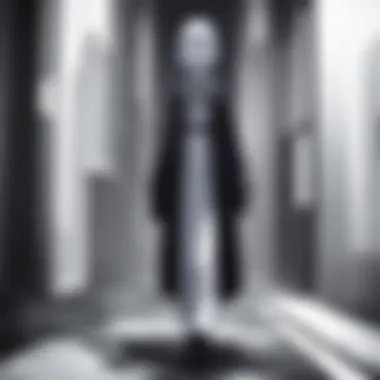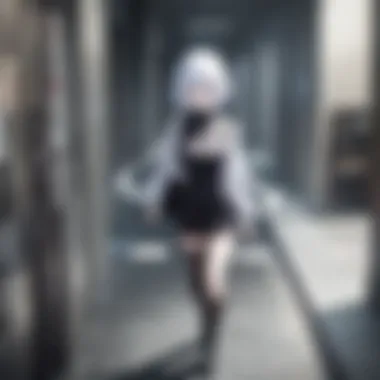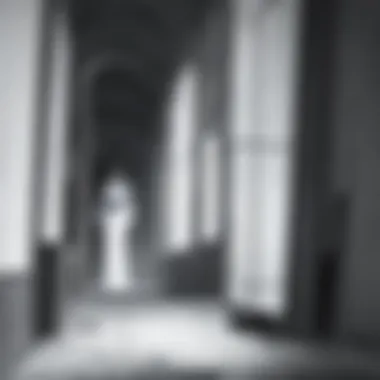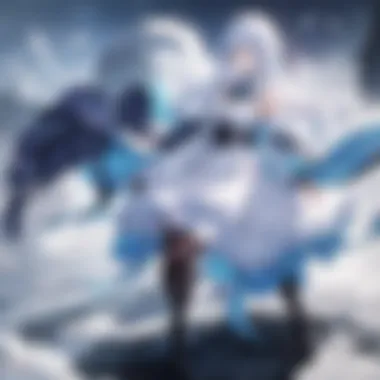Unraveling the Mysteries of Ghost Hunt Anime Episodes


Intro
This anime series intertwines elements of horror and mystery, inviting audiences into a world where the supernatural intrudes into our reality. 'Ghost Hunt' captivates viewers with its nuanced exploration of ghost hunting, delving deeper than mere thrills.
Anime Series Overview
Brief synopsis of the anime series including plot summary and key themes
'Ghost Hunt' follows students from the Shibuya Psychic Research Company as they engage with various hauntings and paranormal activities. The squad often uncovers dark secrets, exploring how both the living and dead interact with each other. The key themes include the significance of accepting the past, confronting grief, and the limits of human understanding when confronted with phenomena beyond explanation.
Preface to main characters and their developments throughout the series
The ensemble cast features notable characters like Naru, the cold and calculating leader, Mai, the naive yet determined junior, and their diverse crew of specialists. As the episodes progress, we witness intricate character growth shaped by personal histories and the weight of confrontational experiences. This dynamic enriches the narrative, inviting viewers to invest emotionally.
Discussion on animation style, soundtrack, and notable episodes
The artistic execution in 'Ghost Hunt' combines detailed character designs with atmospheric backgrounds that refrain from cliched horror tropes. With auditory elements playing a significant part, the eerie soundtrack enhances the unsettling vibe perfectly matching the standing tension. Noteworthy episodes like 'The Bloody House' establish both visual and emotional impact through expertly crafted sequences.
Character Analysis
Detailed breakdown of main characters, their personalities, and motivations
The depth of characters like Naru and Mai cannot be understated. Naru, driven by ambition, struggles with personal expressions while Mai displays resilience developed through dark encounters. Other characters are equally integral, each bringing layered complexity and contributing to the overall thematic form of the show.
Character relationships and dynamics within the series
The interplay among characters illustrates real-world dynamics such as trust, respect, rivalry, and budding friendships. Mai's rapport with Naru touches on mentorship and hints at deeper emotional connections, despite the complex interactions.
Impact of characters on the overall storyline and fan theories
Fans passionately discuss character arcs and relationships, resulting in extensive fan theories that enhance engagement within the community. Characters shape trajectories of episodes, influencing how the narrative unfolds dramatically while leaving enthusiasts guessing.
Genre Spotlight
Prologue to the specific genre of the anime series being discussed
'Ghost Hunt' stands out in the supernatural horror genre, blending investigative techniques with psychological explorations. This hybridization fosters storytelling that remaining deeply unsettling and intellectually engaging.
History and evolution of the genre in the anime industry
Supernatural horror has shaped anime defining thematic norms, tracing back to early works. Utilization of ghost stories provides insight into human fears, with adaptations often showcasing how cultural beliefs affect perceptions of fright.
Notable series within the genre, similarities, and differences
Series like 'Paranoia Agent' and 'Another', while differing styles, curate an equally intense atmosphere. Similarities lie in narratives that delve into psychological distress, but diverge in execution demonstrating rich scope and range.
Behind-the-Scenes Insights
Exploration of the production process, from concept to screen adaptation
Behind 'Ghost Hunt' lies a complex journey displaying attention to detail and narrative faithfulness. Creators strive for authenticity, drawing from research documenting paranormal occurrences across history.
Challenges faced during production and the success factors of the anime series
The production team confronted backlash due to its dark themes, but authenticity lent it strength. Viewership indicates a commitment to serious storytelling emerged over the series’ duration as audiences grappled with uncomfortable yet relatable truths in fear.
The intricate balance of ghostly themes, character dynamics, and engaging storytelling speaks greatly to the importance of narrative integrity in supernatural anime.


The layers present in 'Ghost Hunt' continue to draw discussions, ensuring its impact persists long term within community discussions. Underlying misconceptions about ghost hunting intersect well with broader societal themes. Audience insights and academic consideration continue to enhance understanding of not just the series but its pivotal place in anime culture.
Foreword to Ghost Hunt
In examining the anime 'Ghost Hunt', it is crucial to understand the foundation upon which it stands. This series offers a captivating glimpse into the world of supernatural encounters, making it relevant in today’s anime landscape. It emphasizes skillful character development and intricate narratives that appeal to both dedicated fans and new viewers.
Overview of the Series
The anime 'Ghost Hunt' is an adaptation of the popular light novel series authored by Fuyumi Ono. The narrative centers on Mai Taniyama, a high school student who becomes inadvertently involved in ghost hunting after an encounter with a spirit at an old school building. She joins Kazuya Shibuya, a confident and somewhat enigmatic paranormal researcher. Together, they lead a specialized team to investigate various unsettling occurrences across Japan. The stories blend elements of mystery with traditional ghostly legends, thereby increasing intrigue and engagement.
Creation and Background
'Ghost Hunt' debuted in 2006 and was brought to life through the acclaimed studio J.C. Staff. This studio is known for its ability to balance intricate storytelling and aesthetics in animation. The adaptation closely follows its source material while introducing viewers to complex themes of fear and understanding of the supernatural. The initial response to 'Ghost Hunt' was encouraging, garnering attention for its mature framing of horror elements in the anime medium. Its careful homage to traditional ghost lore situates it within a unique niche that remains appealing even today.
Overall, connecting the series with its background enhances viewers' appreciation and hones their critical views on how it has influenced subsequent works in the genre.
Main Characters
The characters in Ghost Hunt serve as the driving force behind the narrative, enriching the viewing experience. By presenting a diverse set of personalities, each character illustrates unique perspectives on the supernatural themes the anime explores. This variety also contributes to character development and interactions, and thus impacts how the audience relates to each character. Understanding Kazuya Shibuya, Mai Taniyama, and Lin Koujo provides insights into the storytelling methods as well as the deeper themes present throughout the series.
Kazuya Shibuya
Kazuya Shibuya is a central figure whose keen intellectual capabilities allow him to approach ghost hunting systematically. His methodical nature contrasts with the often chaotic world of the supernatural. Kazuya exhibits strong leadership, which is crucial when faced with terrifying mysteries. He can often grasp complex phenomena that others find difficult, thus making him both an enigmatic and admirable character. His skepticism towards the supernatural builds tension in the series, as his judgments often contribute to crucial storylines.
Mai Taniyama
Mai Taniyama stands as the series’ emotional core. She begins her journey as a relatable student, pulled into the world of ghost hunting unexpectedly. As the narrative unfolds, Mai exhibits remarkable growth. Her evolution reflects resilience and accuracy. By aligning her with the audiences' perspectives, fans become emotionally invested in her character. Ghost Hunt emphasizes her development through personal challenges and ethical decision-making.
Lin Koujo
Lin Koujo introduces an intriguing dynamic to the character ensemble. His reserved demeanor intrigues the audience and propels the storyline. With roots in mysticism, Lin retains knowledge that blends Eastern practices with Western beliefs about spirits. This duality permits diverse representation in paranormal themes. Typically observing rather than delving straight into conflict, Lin's calming presence often guides the group through intense situations. His background provides insight into cultural nuances, which enriches the narrative.
Through these main characters, Ghost Hunt provides a clear lens to explore deeper themes, such as trust and fear, as well as society’s myriad reactions to the unknown.
Episode Breakdown
The Episode Breakdown is a critical section of this article. It not only delineates the structure of the series but also highlights the narrative progression across its multiple installments. Understanding each episode allows viewers to appreciate the detailed plot development and character arcs that unfold. This section benefits the reader by offering insight into how each story connects to overarching themes and character relations in 'Ghost Hunt.'
Season One Overview
In Season One of Ghost Hunt, the story roams through various intriguing cases of the paranormal. The season serves as the initiation into the complex world of supernatural investigations led by Kazuya Shibuya. Each episode exposes a different ghost story, creating a rich tapestry of eerie encounters, psychic phenomena, and personal growth among the characters. This season sets the tone for the series, demonstrating how frightening occurrences are coupled with the pursuit for truth.
One of the notable aspects to highlight is the captivating blend of irreverent humor with terrifying situations. Viewers see the evolution of Mai Taniyama, who transforms from a curious high school girl into a competent ghost-hunting assistant. This change is essential because it establishes a foundation for her relationship with Kazuya.
Not only does the season focus on ghostly events, but it also touches on psychological themes such as fear and human spirit. It paves the way for deeper analysis concerning how individuals react to forces beyond their understanding.
Key Episodes and Their Significance
Certain episodes in Ghost Hunt redefine the viewing experience and solidify viewer engagement. Here are some noteworthy episodes that stand out and their significance:
- Episode 1: The Youkai History - This premiere episode introduces the main cast and establishes the central premise effectively. Viewers gain an understanding of Kazuya's professional presence and the dynamics of his team.
- Episode 6: The Haunted House - This particuar episode takes a more emotional turn. It explores personal traumas within the team members as they confront their fears. The human aspects of fear really show the audience that they are dealing with relatable characters.
- Episode 9: The Bow - This episode rivets attention with deep character development focus on Mai. Her experiences reveal her moral courage and commitment, further emphasizing her growing bond with Kazuya.
Key episodes contribute towards the foundational growth of narrative themes while enhancing audience attachment to characters. Through strategic plot devices and character interactions, these episodes underscore vital facets of the visceral mythology presented throughout the series. Jubilant laughter turns into paralyze fear, leaving viewers longing for more adventures with the Ghost Hunt team.
Themes and Motifs
The significance of themes and motifs in Ghost Hunt is profound. They provide depth beyond the haunting encounters and mystery. Facets of human experience are reflected in how characters relate to the supernatural elements. The exploration of fear and trust sheds light on profound psychological dimensions. These themes express broader societal issues and encourage discussions on the nature of reality.


The Nature of Fear
Ghost Hunt intricately examines the concept of fear, harnessing it not just for thrills but as a means to explore character psyches. Each encounter with the supernatural represents different fears. The series transcends basic horror tropes, delving into vulnerabilities and emotional reactions. This approach allows the audience to relate to characters on a deeper level.
Fear fuels the narrative arc. As characters confront their fears, they evolve. Mai Taniyama’s initial skepticism transforms into bravery. Such dynamic character development reflects the multifaceted nature of fear—both debilitating and motivating. It is fascinating how the show uses paranormal occurrences to explore real-life anxieties, generating a rich commentary on human conditions.
Friendship and Trust
In the world of Ghost Hunt, friendship and trust are cornerstones in overcoming challenges. The relationships among characters anchor the narrative, illustrating that unity is key when facing external and internal demons. Kazuya Shibuya and Mai Taniyama personify this aspect—each episode reveals their growing trust that forms the foundation for tackling supernatural mysteries together.
The depiction of relationships amid fear accentuates emotional stakes. Betrayals and misunderstandings introduce tension but ultimately strengthen bonds. Stresses faced while ghost hunting serve as tests, revealing true loyalties. Through these lenses, the anime shows how collective effort and trust create a sturdy defense against fear, encouraging viewers to value human connections in confronting their own fears.
"Through the eerie silence and chilling frames, the anime articulates complex themes of trust, highlighting interpersonal dynamics."
This exploration of themes presents an insightful measure not just for the individual growth of characters but for viewer reflection on personal connections. Overall, these motifs establish Ghost Hunt as a thought-provoking blend of horror and emotional resonance.
Art and Animation Style
The art and animation style in "Ghost Hunt" plays an crucial role in conveying the series' atmosphere and themes. This section unravels how the visual elements enhance the storytelling, creating an immersive experience for viewers. The chosen aesthetic influences not just how we perceive the events on screen, but also contributes to the emotional tone of the narrative.
Visual Aesthetics
Within the realm of supernatural storytelling, the visual aesthetics of "Ghost Hunt" stand out. The character designs are distinct yet relatable, giving life to each individual’s personality. Mai Taniyama’s vibrant curiosity contrasts sharply with the stoic demeanor of Kazuya Shibuya, illustrating the tension between fear and determination.
The careful application of color palettes also brings depth. Darker tones are typically used to signify danger, while warmer hues suggest safety, creating an emotional landscape. Setting plays a vital role as well. Each location evokes a strong sense of place, from abandoned buildings to eerie forests, emphasizing the show’s central themes. The attention to detail in these various backdrops fosters an atmosphere ripe for ghostly happenings. Overall, the visual aspects aid in telling a story that transcends mere narratives about ghost hunting; they create a world that's almost palpable.
Animation Quality
Animation quality is another significant factor that merits attention in "Ghost Hunt." The movement of characters is fluid and responsive, which is vital during intense investigative sequences. The quality enhances thrill moments, allowing the audience to visually immerse themselves in the day's urgent circumstances faced by the characters. Well-executed fight scenes and sudden specter confrontations are marked by sharp visual clarity, contributing to the tension.
Additionally, emotional scenes benefit from thoughtful animation choices that amplify subtle expressions. The connection between animated characters and their viewer hinges on this quality aspect. A well-crafted scene can transform an ordinary narrative moment into one of poignancy. Ensuring a consistently high level of animation also signifies the production team’s commitment to storytelling, indicating to fans that their experiences are valued.
In summary, both the visual aesthetics and animation quality in "Ghost Hunt" enrich the viewing experience significantly. They not only glorify expressive character designs and effective storytelling but also leave a lasting impression on anime enthusiasts. This dedicated approach showcases how integral art and animation are in enriching the narrative fabric of the series.
"The art and animation serve as a silent, but impactful extension of the story that no words can encapsulate."
Cultural Impact
Understanding the cultural impact of Ghost Hunt is essential for grasping its place in the anime community. The series successfully explores the supernatural through compelling storytelling while raising broader questions about its reception and lasting legacy.
Reception Among Fans
Ghost Hunt holds a special place in the hearts of fans. When it first aired, it sparked conversations not only about its spooky themes but also about the psychological elements that linked the characters. The diverse cast, including Kazuya Shibuya and Mai Taniyama, provides perspectives that resonate with many viewers. Social media platforms such as Reddit and Twitter have large communities devoted to discussing the series, signaling its influence and relevance.
Fans appreciate the character development and suspenseful plot twists. Many have engaged in fan arts and discussions about their favorite episodes and characters. This engagement creates a bond among viewers, enhancing their interest not just in the anime, but in the themes it presents. As a result, the series fosters a community that extends beyond episodic content.
Influence on the Genre
The influence of Ghost Hunt extends beyond its episodes. It has had a measurable effect on the supernatural anime genre by blending traditional horror elements with psychological nuances. This unique combination enhances its storytelling and sets a preparatory example for newer series.
Several modern anime incorporate ghost-hunting tropes with their own twists. By looking at series like Paranormal Agent and Another, we can see how elements reminiscent of Ghost Hunt are adapted, showcasing its lasting impact.
The detail and depth shown in Ghost Hunt invites the use of more intricate narratives. As anime creators become influenced by its storytelling style, we can expect a variety of series that emulate its strong character dynamics and complex narrative structures. The result is a more enriched and diverse anime landscape that challenges its audience, pushing them to think critically about the mutually interdependent values of the characters and the plots.
In essence, Ghost Hunt does not just sit as an isolated piece of media within the supernatural genre; it forms a foundational element that impacts future storytelling in the realm of anime.
Availability of Full Episodes
The availability of full episodes of Ghost Hunt is a cornerstone for both casual viewers and dedicated fans. Understanding how to access the entire series is essential for appreciating its nuanced storytelling and captivating character development. For viewers new to the series, access to watch the full episodes enhances the experience, allowing them to immerse themselves fully in the plots and character arcs without interruptions. Additionally, this section addresses various avenues through which one can access the series legally, ensuring quality viewing and supporting the creators behind this anime.
Streaming Platforms


Many anime lovers turn to streaming services for convenience. Ghost Hunt is available on numerous platforms, making it easier for fans to find and watch. Here are a few prominent options:
- Crunchyroll: Known for its extensive library, this platform frequently updates its collection of anime. Users can stream Ghost Hunt with subtitles, ensuring an engaging viewing experience.
- Hulu: With various anime titles in its catalog, Hulu offers Ghost Hunt as part of its service. This is beneficial because it provides both subbed and dubbed versions, catering to different preferences.
- Funimation: This platform often features anime that appeals to English-speaking audiences. Users can access Ghost Hunt in both dubbed and subbed formats, making it more accessible for non-Japanese speakers.
These platforms usually require a subscription, but offer trials to familiarize viewers with their offerings. Watching Ghost Hunt through these services supports the anime industry while ensuring high-quality playback and proper translations.
and Blu-ray Releases
For collectors and enthusiasts, Ghost Hunt is available on DVD and Blu-ray. These physical formats allow for ownership and provide various special features. The releases often include:
- Cover Art: Unique packaging, often featuring key characters from the series.
- Episode Guides: Booklets that provide summaries and character details can enhance the viewing experience.
Purchasing the DVD or Blu-ray versions cater to those who prefer tangible media over digital options. It's also a way to preserve content for dedicated viewing over time. Collectors of the series will find this important, as having a physical piece corresponds with the act of appreciating the art form.
Many fans prefer owning physical copies of their favorite anime. This helps maintain engagement with the series even when streaming services update their libraries.
Having access to full episodes of Ghost Hunt, whether through streaming or physical copies, emphasizes its significance in the realm of supernatural anime. Thus, viewers can dive deep into the varied layers of the narrative and enjoy the complexities that make it memorable.
Merchandising and Spin-offs
Exploration of 'Ghost Hunt' extends beyond its narrative and themes. Merchandising and spin-offs play a vital role in a series's longevity in popular culture. For fans of the show, merchandising provides a way to connect with the series more personally. It creates a tangible world where one can own a part of the franchise. This not only enhances the fan experience but also allows the creators to reach a larger audience.
Understanding the impact of memorabilia such as action figures, posters, and apparel is essential. These items serve as conversation starters and connectors in fandom. Furthermore, they enrich the emotional bond fans have with the series, bridging the narrative with their daily lives.
Additionally, spin-off series, if produced carefully, have potential to broaden the lore of 'Ghost Hunt.' They can tackle unexplored story arcs or side characters that did not receive enough attention. Leveraging both new and existing elements could revitalize interests in the original series while providing satisfaction to dedicated fans.
Related Merchandise
Various types of merchandise associated with 'Ghost Hunt' make an imprint in the minds of fans. Offerings range from simple items like collectible trading cards to complex structures like dioramas and figurines.
- Collectible Figures: High-quality figurines featuring characters such as Mai Taniyama or Kazuya Shibuya.
- Posters: Officially branded posters that depict stunning artwork from the series, providing aesthetic appeal.
- Closurey Accessories: Phone cases, bags, and other personal items featuring imagery and quotes from the show.
These products satisfy both aesthetic appeal and sentimental value. They help maintain interest over time, allowing consumers to display their fandom beyond standard media consumption. Fans take pride in these collectibles, which can be displayed in homes or offices, serving as a connection back to the show.
Adaptations and Spin-off Works
Adaptations and spin-offs are significant for their capacity to expand upon the source material. They often allow for deeper explorations or retellings of existing narratives. When it comes to 'Ghost Hunt,' understanding and examining potential adaptations becomes crucial.
While there aren't numerous spin-offs specific to 'Ghost Hunt,' announcements around adaptations can generate discussion within the fan community. Fans look out for any announced projects that may come forth based on the rich universe presented in the anime. Possible considerations include:
- Light Novels or Manga Series: These could extend stories beyond the anime’s conclusion, inspired by events from the animated series itself.
- Radio Dramas: Offer a different medium through which fans can enjoy the characters in new storylines, capturing their essence in audio form.
In summary, the potential for adaptations represents a thriving ecosystem that can keep a franchise relevant. They give life to characters in new ways that fans may not have previously anticipated.
Epilogues
Final Thoughts on Ghost Hunt
The characterization in Ghost Hunt captures the struggles and complexities faced by ghost hunters, revealing how personal experiences shape human interactions in daunting situations. Examining these intricacies allows for deeper analysis and appreciation of the narrative that often pixelates blurring boundaries of traditional horror.
Moreover, the refreshingly human cast of characters emphasizes relatable strengths and insecurities. These aspects forge a connection, making the fright and tension resonate more authentically with the audience. As a result, the series leaves viewers contemplating its essence long after the credits roll.
Impact on Future Anime Series
Ghost Hunt notably influenced the trajectory of subsequent anime expressions by reiterating the importance of strong character-driven narratives. Its approach to spectral phenomena demonstrated that horror need not exist in isolation but rather integrate multiphysical mental frameworks. Many animators and storytellers drew inspiration from its rich lore and emotional gravitas.
Classical tropes associated with horror genres often rely heavily on clichés. However, Ghost Hunt provoked innovative thought through its blend of psychological angles and empathetic dialogue. Cumulatively, these facets contribute to transcending normative storytelling in anime.
The introduction of complex themes such as personal hauntedness delicately alters future works' dynamics. In light of elementary hauntology frameworks, creators have started embedding new conflicts into their story arcs. They reflect upon unresolved emotion and mystery rather than purely relying on obvious scare tactics.
Less evidently influenced anime takes on inference-informed placements, thereby encouraging similar thematic implementation in horror genres down the line. Overall, Ghost Hunt reshaped expectations produced by its narrative approaches while giving insights into personal interpretation occasionally awed audiences long after showings.
“It challenges the audience as much as it entertains, leading folks to enter deeper dialogues about supernatural realities.”
With an enriching cultural footprint, Ghost Hunt continues guiding aspiring creators and influencing contemporary offerings navigating perceived horror worlds. In summary, it merges narrative depth with genre potential, considering emergences of anime storytelling—efficient in reanimating inherent references celebrated across manga landscapes.







